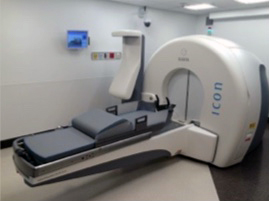With the support of the University of Alberta Hospital Foundation, the Scott & Brown Families Advanced Imaging and Gamma Knife Centre will open at the University of Alberta Hospital in Edmonton in December 2017. A multidisciplinary team of neurosurgeons, radiation oncologists, medical biophysicists, radiation therapists and specialized nurses will take care of patients in this state-of-the-art facility, the only Gamma Knife stereotactic radiosurgery (GKSRS) treatment centre in Alberta. The opening of this unit is a good opportunity to review what we know about the use of GKSRS for treatment of vestibular schwannomas, and look at some ideas that are emerging.
As imaging technology advances and access to MRI scanning grows, vestibular schwannomas (VS) are increasingly being diagnosed when they are small and minimally symptomatic. While this means that more management options may be available, navigating the choices can be challenging. The main goal in taking care of patients with these tumours is to control tumour growth while maintaining neurologic function and quality of life, balancing the risks of neural deficits and troublesome symptoms resulting from the tumour against those caused by treatment. Since VS are histologically benign, both tumour control and functional preservation need to be sustained for a long period of time, often decades. In general, as seen on the Acoustic Neuroma Clinical Care Pathway, management options can include a “watch and wait” approach that delays the adverse effects of radiation or surgery, or active intervention in the form of radiosurgery or microsurgical removal.
When considering the many studies that have been done in this area, it is important to keep a few things in mind: different institutions may vary in the care pathways they establish, in the way they measure and report outcomes, and in the factors, that influence how treatment options are selected, and these differences mean that direct comparison of one study to another should be done with caution. Long-term follow-up is critical since some events, such as hearing deterioration, develop over many years. At the same time, treatment strategies evolve, so the results reported from a study with a long follow-up period may not reflect treatment as it would be given today. Above all, each patient has a unique set of symptoms, concerns and goals, and the available data must be interpreted and applied in the personal context of that individual.
Tumour growth control

Since radiation doesn't necessarily cause tumours to shrink, a tumour is considered controlled whether its size decreases or remains the same on follow-up imaging. If growth is not demonstrated before treatment, however - as in the case of a tumour that is treated on diagnosis after a single scan - then it is not known whether the treatment is truly responsible for controlling tumour growth or whether the tumour was not growing anyway. In addition, although a tumour may demonstrate some growth over time, it may remain small enough that no intervention is required.
Both of these factors affect how the “control rate” reported in a study should be interpreted. Higher radiation doses provide better rates of tumour control, but also lead to more injury of the adjacent cranial nerves and brainstem. Treatment plans in the modern era strike a balance between these considerations. Overall, across many studies and tens of thousands of patients, GKSRS has shown high rates of tumour control. These results are largely durable, as studies involving 10-15 years of follow-up show that a small proportion of treated tumours demonstrate growth. However, in this group of tumours that continue to grow after GKSRS and require another treatment, intervention can be more difficult and is associated with higher risks than treatment of non-irradiated tumours.
Effects on cranial nerves VII (facial nerve) and V (trigeminal nerve)
The facial nerve is located next to the vestibulocochlear nerve, and tends to be draped or stretched over the surface of VS as they grow. Dysfunction of the nerve, whether due to the tumour or treatment, can cause weakness or paralysis to the same side of the face. The trigeminal nerve controls facial sensation, so neuropathy can result in numbness or pain to the face. Many patients can have improvement or resolution of these symptoms following GKSRS treatment, but new symptoms or worsening of existing ones can also occur as a result of treatment. In general, a large number of studies show that the radiation doses and plans used today result in low rates of facial or trigeminal nerve dysfunction.
Hearing preservation
The issue of hearing preservation is perhaps the most discussed when assessing the role of various management modalities. While most VS are diagnosed because they have caused hearing impairment, some patients have useful or even normal hearing at the time of diagnosis. Hearing classes are defined by audiogram testing, and on the Robertson-Gardner Scale grades I (“good”) and II (“serviceable”) are together considered serviceable. Historically, patients were advised that they would eventually lose hearing on the side of the VS - over time with conservative management, accelerated following radiosurgery, and immediately after surgery. But loss of hearing after treatment has not been as inevitable as previously thought, so there is increasingly a search for factors that may allow “hearing preservation” to be a realistic long-term management goal.
Some studies have found that certain variables are associated with a greater likelihood of retaining serviceable hearing after GKSRS: younger patient age, smaller tumour, and having better hearing to start, as measured on audiogram and reflected in normal auditory brainstem response. These factors can’t be altered, but others can be, such as the total dose of radiation given and in particular the amount of radiation received by the cochlea, the sensory organ of hearing. Because of these findings, treatment plans now place a limit on cochlear radiation exposure.
More recently, some investigators have asked whether early treatment - i.e. before hearing has declined - can prevent long-term hearing loss. For instance, one study compared patients who underwent “proactive” GKSRS with those who had a “wait and see” approach, and found that the GKSRS-treated group had higher rates of hearing preservation. However, the follow-up was short, and hearing decline in the “wait and see” group was higher than in many other studies. Another group found that among patients with class I hearing who underwent GKSRS, those who were treated earlier following diagnosis had a greater likelihood of retaining class I and class I/II hearing compared to those who were treated after a longer period of observation. This finding also seemed to suggest that upfront GKSRS treatment may offer a better chance of preserving near-normal hearing, compared to a “watch and wait” approach. However, the pre-treatment pure tone average (PTA) component of the audiogram was significantly worse in the late-treatment group, which may have biased the results. Overall, the data do not clearly support undertaking early GKSRS for the purpose of preventing hearing loss, but further studies are ongoing to help determine how GKSRS may fit into a hearing preservation strategy.
Effects on imbalance and tinnitus
While facial nerve function and hearing receive a great deal of attention in discussions about VS management, many patients experience other symptoms that can have a greater adverse effect on their quality of life. These symptoms include imbalance, dizziness and tinnitus (ringing in the ears), and may improve or worsen over time. The impact of GKSRS on them is not entirely known. Some studies suggest that patients who have undergone GKSRS overall have a quality of life that is similar to that of patients without VS. Since these effects are entirely subjective, there is clearly a need to better understand the symptoms that are specific to VS patients, and how their day-to-day function and quality of life are affected by different management strategies.
This article is a very brief overview of some factors that are considered when GKSRS is a management option for VS. Comparison with other modalities of treatment is purposely not made here, as the relative risks and benefits need to be assessed in the context of each patient individually. It is therefore essential that patients communicate closely with their multidisciplinary care team about their management priorities, and together determine the most appropriate treatment strategy for them.

Karolyn Au, MD, MSc, FRCSC completed fellowships in skull base tumour surgery and neuro-oncology in Toronto and Miami, then returned to her hometown of Edmonton to join the neurosurgical faculty at the University of Alberta. Outside of the OR, Dr Au is focused on developing clinical care pathways that streamline investigations and treatment and facilitate communication for patients with acoustic neuromas and other intracranial tumours.
Together with her colleagues in neurosurgery, otolaryngology and radiation oncology, she looks forward to the opportunities for treatment and research offered by the new Gamma Knife facility in Edmonton.
